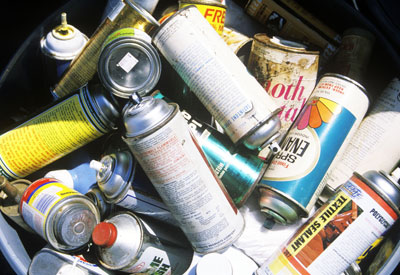Selecting Alternatives
 A wide variety of organic solvents are used in painting, cleaning and other industrial and commercial operations. Most of these solvents are classified as volatile organic compounds (VOCs) and are regulated as air pollutants that contribute to smog and ozone formation, by the USEPA. These materials have a range of physical properties and a range of health and environmental hazards. You and your suppliers currently select solvents for your use by evaluating physical properties and hazards. Photochemical reactivity is another chemical property that can guide selection of solvents to minimize smog-related air pollution in Minnesota.
A wide variety of organic solvents are used in painting, cleaning and other industrial and commercial operations. Most of these solvents are classified as volatile organic compounds (VOCs) and are regulated as air pollutants that contribute to smog and ozone formation, by the USEPA. These materials have a range of physical properties and a range of health and environmental hazards. You and your suppliers currently select solvents for your use by evaluating physical properties and hazards. Photochemical reactivity is another chemical property that can guide selection of solvents to minimize smog-related air pollution in Minnesota.
Photochemical reactivity (in the VOC context) is a measure of the tendency of a chemical to breakdown in the atmosphere in the presence of sunlight and other pollutants to form ozone. Atmospheric chemistry is complex and the amount of ozone produced by VOC pollution will vary with atmospheric conditions.
Maximum Incremental Reactivity (MIR) is one measure of photochemical reactivity, which estimates the weight of ozone produced from a weight of a chemical (e.g. lbs ozone per lb of chemical) under worst case conditions. As conditions change the amount of ozone generated will change, but as a general rule, chemicals with high MIR values will generate more ozone under most conditions than chemicals with lower MIR values. MIR values were developed in California and are currently used for some regulatory purposes in California and Texas. There are significant complexities in using photo chemical reactivity as a regulatory tool. The USEPA, and a number of states, including Minnesota, use MIR values for modeling, estimation, and prediction of air pollution. USEPA is encouraging states to use photochemical reactivity in developing their State Implementation Plans (SIP) for ozone.
Using solvents with lower MIR values will help reduce air pollution and specifically ozone and smog formation. Photochemical reactivity correlates with other types of reactivity and toxicity so as a generally rule solvents with lower MIR values will be safer and less toxic in other respects also, although toxic effects should be reviewed independently in any solvent review or selection.
Where feasible, try to use solvents with lower MIR values. For example, a pound of xylene released to the air creates roughly five times more ozone than a pound of methyl ethyl ketone (MEK), and more than 20 times more ozone than a pound of acetone.
Safer Products that Work
Finding safer products that work is never an easy task. This document provides a list of products, considered by MnTAP, to be free of Hazardous Air Pollutants, and have reasonably low ozone (smog) generation potential. |PDF 298KB|
Some common solvents and their MIR values
| Name | MIR |
|---|---|
| Formaldehyde | 9.46 |
| 1,2,4-Trimethylbenzene | 8.87 |
| Xylenes (Mixed Isomers) | 7.9 to 8.4 |
| Phenyl Cellosolve | 4.49 |
| Toluene | 4.0 |
| Methyl Isobutyl Ketone | 3.88 |
| Cellosolve | 3.71 |
| Ethylene Glycol | 3.13 |
| Butyl Cellosolve | 2.9 |
| Diethylene Glycol Monomethyl Ether | 2.66 |
| Styrene | 1.73 |
| Methyl Ethyl Ketone | 1.48 |
| Ethylene Glycol Monomethyl Ether Acetate | 1.15 |
| Methanol | 0.67 |
| Acetone (VOC exempt) | 0.36 |